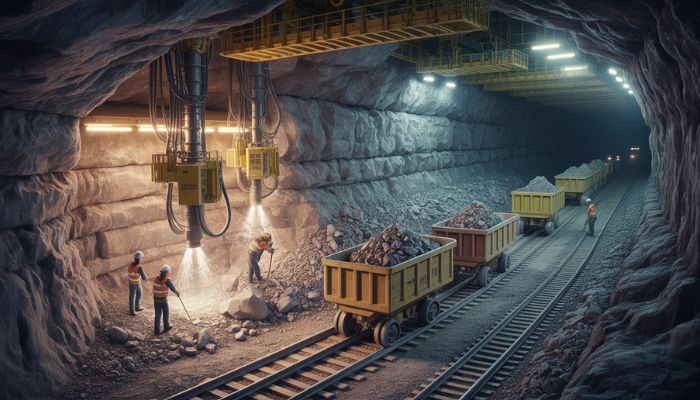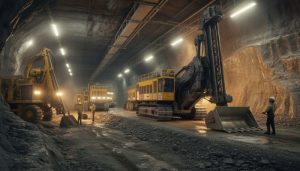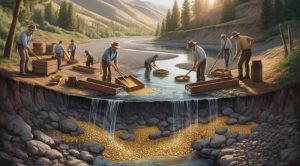On This Page
Table of Contents
Hard rock gold mining refers to the extraction of gold from solid rock formations that contain gold ore. Unlike placer mining, where gold is collected from loose sediment in riverbeds, hard rock mining involves digging into the earth to reach the ore veins containing the valuable gold. This ore can be located miles below the surface, which means specialized techniques are needed to retrieve and process the material.
The Stages of Hard Rock Gold Mining
Hard rock gold mining involves several critical stages that miners must follow to successfully extract gold. These stages are exploration, drilling and blasting, crushing, milling, and chemical extraction.
Exploration and Site Evaluation
The first stage in hard rock mining is exploration. Geologists and mining experts conduct surveys of potential areas to determine the best locations to mine. They study the composition of the rock, search for gold-bearing veins, and evaluate the feasibility of extracting the gold in those areas.
Once a promising site is identified, it is essential to assess the ore’s quality and quantity. Geological techniques, such as core sampling, help provide insight into the amount of gold that can be expected from the deposit, guiding miners in planning the excavation process.
Drilling and Blasting
Drilling and blasting are essential to accessing the gold ore trapped within solid rock. Once the mining site is ready, drilling machines drill into the rock to create holes for explosives. Blasting is a necessary step to break the rock into smaller pieces, making it easier to transport and process.
Crushing and Milling
Once the rock is broken into smaller pieces through drilling and blasting, the next stage involves crushing the material. A rock crusher for gold mining is used to reduce the size of the rocks. Crushers can be either jaw crushers, cone crushers, or impact crushers, depending on the type of ore being mined.
After crushing, the next step is milling. The crushed rock is ground into fine powder in a mill. This fine material is then processed further to isolate the gold particles from the remaining ore. The goal of crushing and milling is to break the rock down sufficiently to expose the gold, which is often embedded in very fine veins within the rock.
Chemical Extraction
The final step in the hard rock gold mining process is extracting the gold from the ore. One of the most commonly used methods is cyanidation, where the ore is treated with a cyanide solution that dissolves the gold from the surrounding material. The gold is then extracted from the solution through chemical processes that separate it from the other elements.
This method is widely used because it is effective in extracting even small quantities of gold. However, it is also controversial because cyanide is toxic and can cause environmental harm if not handled properly. Many mining companies are now focusing on safer alternatives to cyanide-based extraction, such as gravity separation or using more environmentally-friendly chemicals.
Hard Rock Underground Mining
When gold is located deep beneath the Earth’s surface, hard rock underground mining is used. Unlike surface mining methods such as open-pit mining, underground mining involves digging tunnels or shafts to reach the ore. This method is typically used when the gold deposit is too deep for surface mining to be feasible.
The process of underground mining is much more labor-intensive and requires significant expertise. Miners must ensure the tunnels are stable and secure, with proper ventilation systems in place. The safety of the miners is a top priority, and specialized equipment, such as support beams, is used to prevent tunnel collapses.
The Role of Rock Crushers in Gold Mining
A rock crusher for gold mining is a crucial tool in the extraction process. Rock crushers break down large rocks into smaller pieces, making it easier to separate the gold from the surrounding material. These machines come in various sizes and types, including:
- Jaw Crushers: Used for primary crushing, where large rocks are broken down into smaller chunks.
- Cone Crushers: Often used in secondary and tertiary stages to reduce the size of the rock further.
- Impact Crushers: Used for softer ores, where high-speed impacts break the rock into smaller pieces.
The Environmental Impact of Hard Rock Gold Mining
While hard rock gold mining is a critical industry, it does have significant environmental implications. The most notable concerns are:
- Habitat Destruction: Mining operations can disrupt local ecosystems and destroy habitats for wildlife.
- Water Contamination: The chemicals used in the extraction process, such as cyanide, can contaminate local water sources if not carefully managed.
- Air Pollution: Dust and particulate matter from mining operations can affect air quality, impacting both the environment and the health of nearby communities.
To mitigate these environmental impacts, many mining companies are adopting more sustainable practices, such as using less harmful chemicals in the extraction process, improving waste management techniques, and reducing water usage.
The Future of Hard Rock Gold Mining
The future of hard rock gold mining looks promising, with ongoing advancements in technology helping to improve the efficiency and safety of mining operations. Some of the key trends shaping the future of the industry include:
- Automation: The use of automated equipment in drilling, blasting, and ore handling is increasing, reducing the need for human labor and improving operational safety.
- Artificial Intelligence (AI): AI is being used to predict ore locations, optimize mining schedules, and enhance processing techniques.
- Sustainable Practices: There is growing pressure on mining companies to adopt greener, more sustainable practices. This includes finding alternative extraction methods that minimize the environmental impact.
FAQ
What is the difference between hard rock mining and placer mining?
Hard rock mining extracts gold from solid rock, whereas placer mining focuses on gold found in loose materials, like riverbeds.
How does a rock crusher for gold mining work?
A rock crusher breaks down large pieces of rock into smaller, more manageable pieces, which makes it easier to extract the gold.
Why is underground mining used for hard rock gold mining?
Underground mining is used when gold deposits are too deep for surface mining. It requires digging tunnels to reach the ore.
What are the environmental impacts of hard rock gold mining?
Hard rock gold mining can cause habitat destruction, water contamination, and air pollution, but sustainable practices are being developed to mitigate these impacts.
What role does automation play in the future of hard rock gold mining?
Automation is improving safety and efficiency by reducing the need for manual labor and optimizing mining operations.
Conclusion
Hard rock gold mining is a complex and technical process that requires specialized knowledge and equipment. From exploration to chemical extraction, each stage plays a crucial role in obtaining gold from solid rock. Through these processes, mining companies can better manage the challenges they face while ensuring the responsible extraction of this precious metal.
Read more about: What are Gold Miners?



